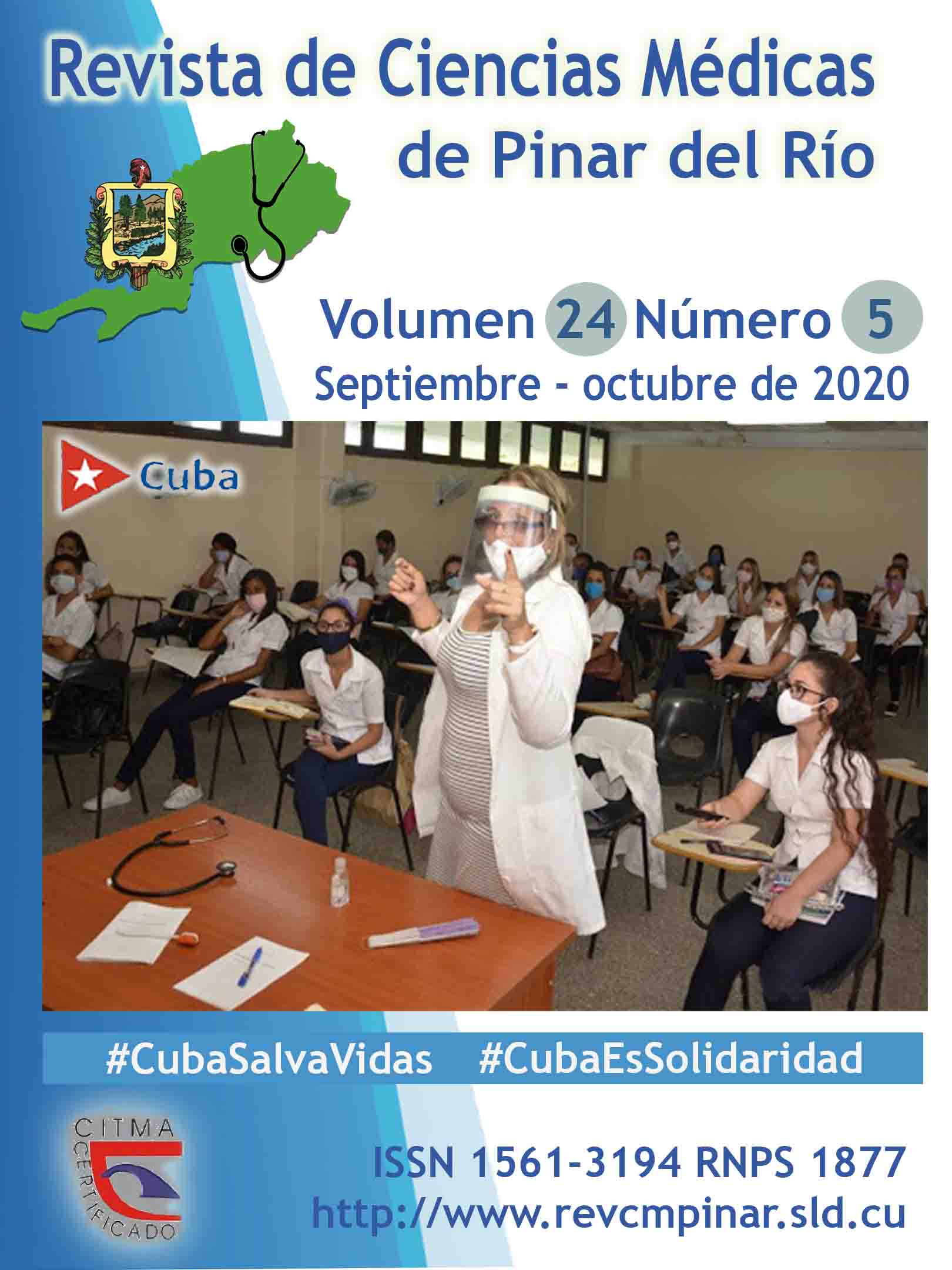Dosimetric characterization of X-ray Surface Radiotherapy Equipments
Keywords:
DOSIMETRY, RADIOTHERAPY, SKIN NEOPLASMS, X-RAY THERAPY, CALIBRATION.Abstract
Introduction: in Cuba, in 2018, a total of 12 070 new cases of skin cancer were diagnosed, from which it is estimated that 11 587 correspond to the non-melanoma type. Radiation therapy with X-rays is considered the first-line treatment in many of these cases. Recently, the national healthcare system acquired four SENSUS SRT-100TM units for treating Non-Melanoma Skin Cancer (NMSC).
Objective: to develop a standardized methodology for the dosimetric characterization of the equipments of surface radiotherapy with X-rays installed in Cuba.
Methods: four SENSUS SRT-100TM radiotherapy equipments were characterized for each of their radiological qualities, in terms of linearity, stability, hemi-reductive layer, reference dose rates, dose profiles, cone factors and percentage of dose in depth. The recommendations of the AAPM TG-61 and the IAEA-TRS 398 were applied for this purpose.
Results: the averages of HVLs (mm Al) and their respective coefficients of variation (CV) were 5.526 - 5.2 %; 1.130 - 2.1 % and 2.007 - 2.1 % for 50, 70 and 100 kV respectively. The yields presented little variability between machines (CV < 3%) and were very similar by the methods "in water" and "in air" (discrepancy < 0.5 %).
Conclusions: the equipments show excellent stability and very similar dosimetric characteristics among them, which allows establishing reference values for eventual external audits and beam readjustments after the maintenance or repairs involving the X-ray generator.
Downloads
References
1. Kim HN, Lee JH, Park HB, Kim HJ, Cho SO. Surface applicator of a miniature X-ray tube for superficial electronic brachytherapy of skin cancer. Med Phys [Internet]. 2018 [Citado 20/05/2019]; 45(1): 29-36. Disponible en: https://pubmed.ncbi.nlm.nih.gov/29106708/
2. Severina P. Development of The Slab Phantom for the Measurements of Irradiation Doses in Superficial X-Ray Therapy [Thesis]. Master’s Final Degree Project. Kaunas University of Technology. Faculty of Mathematics and Nature Sciences; 2018. [Citado 20/05/2019]: [aprox. 60p.] Disponible en: https://epubl.ktu.edu/object/elaba:29009047/
3. Fahradyan A, Howell AC, Wolfswinkel EM, Tsuha M, Sheth P, Wong AK. Updates on the Management of Non-Melanoma Skin Cancer (NMSC). Healthcare (Basel) [Internet]. 2017 [Citado 20/05/2019]; 5(4): 82. Disponible en: https://pubmed.ncbi.nlm.nih.gov/29104226/
4. Nazco Torres J, Labrador Díaz JF, Castro Crespo D, Aguiar Ferro Y, Rodríguez Hernández Y. Tratamiento de tumores de piel con SENSUS SRT-100TMen Centro Oncológico pinareño. Rev Ciencias Médicas [Internet]. 2019 [Citado 20/05/2019]; 23(6): 817-826. Disponible en: http://revcmpinar.sld.cu/index.php/publicaciones/article/view/4082
5. Anuario estadístico de salud. 2018. Ministerio de Salud Pública, Dirección de registros médicos y estadísticos de salud. [Internet]. La Habana; 2019. Disponible en: https://files.sld.cu/bvscuba/files/2019/04/Anuario-Electr%C3%B3nico-Espa%C3%B1ol-2018-ed-2019-compressed.pdf
6. Nestor MS, Berman B, Goldberg D, Cognetta A, Gold M, Roth W, et al. Consensus Guidelines on the Use of Superficial Radiation Therapy for Treating Nonmelanoma Skin Cancers and Keloids. J Clin Aesthet Dermatol [Internet]. 2019 [Citado 20/05/2019]; 12(2):12-18. Disponible en: https://pubmed.ncbi.nlm.nih.gov/30881578/
7. Nazco Torres J, Torres Valle A, Labrador Díaz JF, Jiménez Ortega U, Castro Crespo D. Estudio del riesgo en radioterapia superficial con SENSUS SRT-100TM usando FMEA y código SECURE MR-FMEA. Revista de Ciencias Médicas de Pinar del Río [Internet]. oct. 2018 [Citado 20/05/2019]; 22(6): 1077-1089. Disponible en: http://www.revcmpinar.sld.cu/index.php/publicaciones/article/view/3762
8. Hill R, Healy B, Holloway L, Kuncic Z, Thwaites D, Baldock C. Advances in kilovoltage x-ray beam dosimetry. Phys Med Biol [Internet]. 2014 [Citado 20/05/2019]; 59(6): 183-231. Disponible en: https://pubmed.ncbi.nlm.nih.gov/24584183/
9. Furstoss C. COMP report: CPQR technical quality control guidelines for kilovoltage X ray radiotherapy machines. J Appl Clin Med Phys [Internet]. 2018 [Citado 20/05/2019]; 19(2):18-21. Disponible en: https://www.ncbi.nlm.nih.gov/pmc/articles/PMC5849838/
10. Canadian Partnership for Quality Radiotherapy. Technical Quality Control Guidelines for Canadian Radiation Treatment Centres; 2016. Disponible en: http://www.cpqr.ca/wp-content/uploads/2017/01/TQC-2016-05-01.pdf
11. Centro Nacional de Seguridad Nuclear. Resolución No. 41/2011. Guía de Seguridad Para la Práctica de Radioterapia; 2011.
12. Sheu RD, Powers A, Lo YC. Commissioning a 50-100 kV X-ray unit for skin cancer treatment. J Appl Clin Med Phys [Internet]. 2015 [Citado 20 de mayo 2019]; 16(2):5182. Disponible en: https://pubmed.ncbi.nlm.nih.gov/26103186/
13. Chair M.AAPM TG-61. AAPM Protocol for 40–300 kV x-ray Beam Dosimetry in Radiotherapy and Radiobiology. Am. Assoc. Phys. Med [Internet]. 2001 [Citado 20/05/2019]; 28(6): 868-893. Disponible en: https://pdfs.semanticscholar.org/1eb3/a9f39f8c051321a4fe2575fa88dd0bfcc8f5.pdf
14. IAEA – TRS 398. Determinación de la dosis absorbida en agua con haces externos [Internet]. Viena; 2005. [Citado 20/05/2019]. Disponible en: https://www-pub.iaea.org/MTCD/Publications/PDF/TRS_398s_Web.pdf
15. IAEA-TECDOC 1151. Aspectos físicos de la garantía de calidad en radioterapia. Protocolo de control de calidad. 2000. https://www-pub.iaea.org/MTCD/publications/PDF/te_1151_prn.pdf
16. British Journal of Radioology. Central Axis Depth Dose Data for Use in Radiotherapy 1996: A Survey of this Supplement Depth Doses and Related Data Measured in Water Or Equivalent Media [Internet]. Central axis dose data for use in radiotherapy; 1996. [Citado 20/05/2019]. Disponible en: https://books.google.com.cu/books/about/Central_Axis_Depth_Dose_Data_for_Use_in.html?id=dvnloAEACAAJ&redir_esc=y
Downloads
Published
How to Cite
Issue
Section
License
Authors who have publications with this journal agree to the following terms: Authors will retain their copyrights and grant the journal the right of first publication of their work, which will be publication of their work, which will be simultaneously subject to the Creative Commons Attribution License (CC-BY-NC 4.0) that allows third parties to share the work as long as its author and first publication in this journal are indicated.
Authors may adopt other non-exclusive license agreements for distribution of the published version of the work (e.g.: deposit it in an institutional telematic archive or publish it in a volume). Likewise, and according to the recommendations of the Medical Sciences Editorial (ECIMED), authors must declare in each article their contribution according to the CRediT taxonomy (contributor roles). This taxonomy includes 14 roles, which can be used to represent the tasks typically performed by contributors in scientific academic production. It should be consulted in monograph) whenever initial publication in this journal is indicated. Authors are allowed and encouraged to disseminate their work through the Internet (e.g., in institutional telematic archives or on their web page) before and during the submission process, which may produce interesting exchanges and increase citations of the published work. (See The effect of open access). https://casrai.org/credit/



